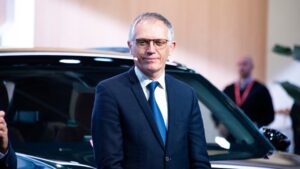The Shakeup at Stellantis: What Carlos Tavares’ Departure Means for the Automotive Giant
In a significant turn of events within the automotive industry, Carlos Tavares—once heralded as the mastermind behind Stellantis—has stepped down from his role as CEO. His exit has sent ripples through the automotive landscape, raising questions about Stellantis’ future direction and the strategic decisions that led to Tavares’ downfall. Here at Extreme Investor Network, we’re diving deep into the implications of this shakeup, the leadership challenges ahead, and what it means for investors and stakeholders alike.
Tavares: A Controversial Leadership Style
Tavares, who led Stellantis since its inception in 2021 through the merger of PSA Groupe and Fiat Chrysler, has been both praised and criticized for his aggressive business strategies. While he was admired for achieving significant cost reductions and profitability during his tenure, many insiders have criticized him for an “arrogant” approach that often sidelined the voices of U.S. executives and employees.
Former employees described a leadership style characterized by a relentless focus on cutting costs and achieving double-digit profit margins under his “Dare Forward 2030” initiative. This relentless pursuit may have come at the expense of product development, employee morale, and crucial relationships with suppliers and unions.
Investor Sentiment Turns Sour
Investors haven’t been shy about voicing their concerns, with U.S.-traded shares of Stellantis plummeting 43% in 2024 prior to Tavares’ exit. This dramatic decline stands in stark contrast to the performance of competitors like General Motors, whose stock rose 55%, and Ford, which saw a modest dip of 9%. Analysts have speculated that investors grew weary of Tavares’ approach, which, while financially focused, led to significant operational missteps—especially in the crucial U.S. market.
The Board’s Surprising Decision
The decision for Tavares to resign rather abruptly came as a shock to many within the company. It was reported that the board had to grapple with “different views” regarding the company’s strategic direction and operational priorities. Tavares’ departure, particularly following a public show of board support, suggests deep-rooted issues within the executive hierarchy.
Repairing Relationships: The Way Forward
Stellantis now faces the challenging task of rebuilding trust with its key stakeholders, including suppliers, employees, and investors. With a 14% workforce reduction since 2020 and ongoing litigation with the UAW—following the union’s dissatisfaction with Tavares’ leadership—Stellantis’ new interim executive committee, led by Chairman John Elkann, must carefully navigate the volatile terrain.
Mismanagement and Market Dynamics
Reports indicate that Tavares’ decisions led to bloated inventories, reduced production, and pricing out key customer demographics from its traditional brands like Jeep and Ram. These missteps have resonated with consumers, creating an opening for market competitors to capture lost market share.
The Immediate Future: Who Will Lead Stellantis Now?
While the company anticipates appointing Tavares’ successor in the first half of 2025, a placeholder executive committee has been established to guide Stellantis through this transition. The selected leader will need to focus not only on stabilizing operations but also on re-engaging with the workforce and enhancing product offerings to meet consumer desires.
Closing Thoughts: The Lesson for Investors
As we reflect on the resignation of Carlos Tavares, it’s evident that leadership in the automotive industry demands not just a firm hand but also an ear open to the market’s beat. While Stellantis is positioned as the fourth largest automaker globally, rebuilding trust and morale will be imperative for reclaiming its competitive edge. At Extreme Investor Network, we urge investors to keep a close eye on Stellantis’ next moves, the dynamics of its leadership changes, and how it plans to address past missteps while preparing for the future.
The conclusion is clear: effective leadership transcends mere profit margins; it is about understanding the intricate web of relationships that form the backbone of a successful corporation in a highly competitive landscape. Stay tuned as we continue to monitor Stellantis’ evolution in the coming months.

